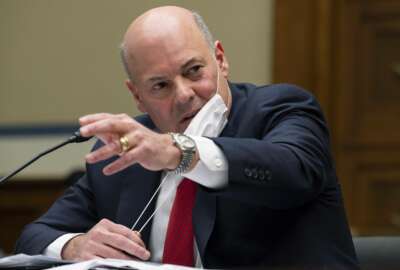

USPS is set to run out of cash by the final quarter of 2022 if it doesn't act on its 10-year reform plan, Postmaster General Louis DeJoy said in an interivew.
Best listening experience is on Chrome, Firefox or Safari. Subscribe to Federal Drive’s daily audio interviews on Apple Podcasts or PodcastOne.
The Postal Service, after 14 consecutive years of net losses, can’t hold onto the status quo and expect different results, Postmaster General Louis DeJoy said in an interview Monday.
The 10-year reform plan unveiled March 23 would get USPS to balance out its finances by 2030, and would avoid a projected $160 billion in additional net losses over the next decade.
To pull this off, the Postal Service is asking its regulatory agency for more flexible delivery targets for 30% of first-class mail, and has already obtained approval to raise mail rates. The plan also looks to shrink the total number of USPS management positions.
The plan is a tough sell for some, but DeJoy said the cost of doing nothing is far greater. If USPS, Congress and the Postal Regulatory Commission don’t move ahead on this plan, the agency is set to run out of cash by the final quarter of 2022.
“Being out of cash, and almost being out of cash, and not running with a cash flow creates an environment that makes it very, very difficult to make any kind of going-concern decisions,” DeJoy said in the interview.
The forecast, while grim, is only the latest in a series of similar predictions. USPS, prior to DeJoy’s tenure, predicted it would run of cash last year because mail volume declines accelerated in the COVID-19 pandemic.
The looming threat of the agency not having enough cash on hand to keep running, he said, is a “tough and ridiculous” problem for an organization as large as USPS to have.
While the plan looks to cut USPS costs, DeJoy said he sees the plan as growth-minded, and focused on bringing in new revenue for the agency.
“It forces you to not address many of the operating and employee and service issues that are quite obvious, as you’re trying to run the organization. So whether we run out of cash next month … or you’re running out of cash a year later, it’s really not a way to run an organization of this stature,” he said.
As part of an ongoing agency restructuring, USPS is making voluntary early retirement offers to avoid a non-voluntary reduction in force. DeJoy clarified the scope of this ongoing headcount reduction of the agency’s administrative workforce. The agency, he said, is looking to shrink its 60,000 employee management workforce by a “small percentage” in the coming months.
The Voluntary Early Retirement Authority (VERA), combined with an average annual attrition rate of 8-9%, should bring the agency closer to its headcount reduction goal. DeJoy didn’t provide an exact figure, but said the agency expects to provide updates by the end of May.
“We’re looking to grow the business, so I need to improve on the business, on the service, and I need good, long-standing, well-versed people in the organization to pull that off,” he said.
While USPS has billed these Voluntary Early Retirements as part of its “reduction-in-force avoidance activities,” DeJoy said the agency doesn’t have plans at this point to conduct a RIF, but also didn’t rule it out.
“We’re going to use every tool in our toolbox to create a viable entity that serves the American people, so nothing is ever off the table. But at this time, that’s not anything that I’m particularly focused on,” he said.
National Association of Postal Supervisors (NAPS) President Brian Wagner said USPS notified employees of their eligibility for a second round of voluntary early retirements in mid-March if the agency decides to go ahead with a reduction in force.
“The Post Office would not just offer a second VERA to offer a second VERA. I think they’re looking at how many are going to take the first one, then do the restructuring which they’ve been working on, and realize that they only need so many positions,” Wagner said in an interview.
Wagner said about 35% of the Executive Administrative Schedule (EAS) employees represented by NAPS are already retirement-eligible and haven’t received a VERA offer.
If USPS does authorize a RIF, Wagner said the agency would cut positions, but that wouldn’t necessarily translate into significant workforce cuts. A management-level hiring and promotion freeze in place since last August, he added, has opened up “landing spots” within the agency that would give RIF-ed employees a shot at another job instead of a layoff.
Wagner, who has served on the NAPS executive board since 2004, said his association has worked well with USPS on management reductions in the past.
“The Post Office has done RIFs before, we’ve been through it, and we’ve worked with the Post Office to find people positions that wanted a job … We literally worked with the Post Office one-on-one to find people who were having a difficult time finding a landing spot, and we were able to get everybody a job who wanted one,” Wagner said.
Wagner said there could be some situations where an employee, facing a RIF, might be offered a new job they don’t want, and prefer to leave the agency instead.
GovExec first reported details of RIF discussions between USPS and NAPS.
The Postal Service is also sharing its vision for the agency with mailers and its commercial customers, but some say the plan amounts to charging higher rates for slower service.
Former USPS executive Stephen Kearney, president of the Alliance of Nonprofit Mailers, said higher rates, combined with relaxed delivery standards, would incentivize industry to send less mail.
“For the non-profit sector, we would love to continue mailing as much as we do now, and to increase it in the future, but if the rates go up that much, it’s just a matter of mathematics. We have to cut back because we have budgets and we have limits on how much we can spend,” Kearney said.
While USPS has yet to raise mail rates, it has the authority to do so from the Postal Regulatory Commission.
“The PRC gave us the pricing flexibility for a reason: We need it. And the reason they gave us the pricing flexibility is because after 10 years of the law, and four years to make a decision, they recognize that mail volume is going down, and that the pricing model that existed 14 years ago is no longer applicable,” DeJoy said.
Paul Steidler, a senior fellow at the Lexington Institute, said USPS, rather than lower standards for any amount of first-class mail, should craft a plan that keeps service at 2012 levels — the last year USPS met its service targets.
“Every time you create you lower service standards, you create less reverence, less respect for that product,” Steidler said.
DeJoy said his background as a logistics executive led him to set realistic goals for first-class mail delivery.
“In my own business, if you had a service that you couldn’t meet without really losing your shirt on, you would adjust it. You would find something that’s actually doable,” he said.
Mike Plunkett, the president and CEO of the Association for Postal Commerce, said the 10-year plan invests heavily in USPS’s package business, where it competes heavily with the private sector.
“That, to me, is one of the big, hidden risks in this plan — throwing a lot of capital into a network where half of the business is in long-term decline and where the other half of business faces tough competition from companies like Amazon, FedEx and UPS — some of the best-run companies in the world,” Plunkett said.
DeJoy said some aspects of the plan have led to “painful conversations,” but added that these changes are necessary to put the agency on firmer financial footing.
“The goal of this plan is to have a viable Postal Service for the American people, have affordable services and have engaged, happy workers with career ambitions committed to the service, just like most successful organizations in the country,” DeJoy said.
Copyright © 2025 Federal News Network. All rights reserved. This website is not intended for users located within the European Economic Area.
Jory Heckman is a reporter at Federal News Network covering U.S. Postal Service, IRS, big data and technology issues.
Follow @jheckmanWFED



